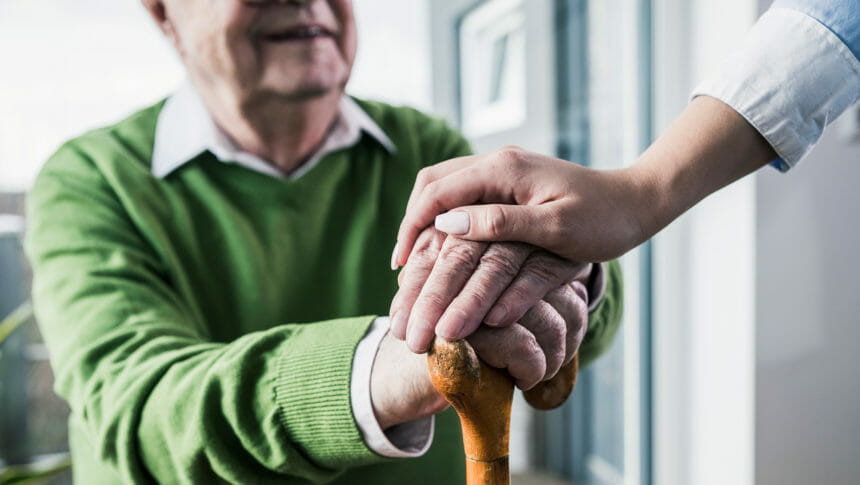
More than 60% of Minnesota’s assisted living communities and nursing homes have implemented programs allowing indoor visits by family members and people deemed “essential caregivers,” according to a joint survey from the state’s two largest senior living and care industry groups.
The survey, jointly administered by Care Providers of Minnesota and LeadingAge Minnesota (the state partner of Argentum in addition to LeadingAge), included responses from 224 assisted living and senior housing providers and 164 nursing facilities.
Senior living communities in the state closed in late March due to COVID-19. In June, families were able to schedule outdoor visits with restrictions, and in early July, state-approved guidelines opened long-term care facilities to indoor visits by essential caregivers.
Active outbreaks of the virus and staffing shortages have kept some facilities closed to visitors of any kind, but a spokesperson for Care Providers of Minnesota, the state affiliate of the American Health Care Association / National Center for Assisted Living, said the associations were “pleased to see that a significant majority have implemented the essential caregiver program.”
“We understood the impact of prolonged social isolation on residents, and we advocated for and partners with our state regulatory agencies to establish guidance with respect to exceptions to the visitation restrictions, including allowing for window visits, outdoor visits and essential caregiver visits,” LeadingAge Minnesota said in a statement to McKnight’s Senior Living. “The essential caregiver program has been launched in nearly three out of four assisted living facilities and housing with services and two-thirds of nursing facilities.”
According to the membership survey, conducted on Aug. 31 and Sept. 1, 73.2% of assisted living and senior housing providers have implemented an essential caregiver program, and 28.4% of residents have designated an essential caregiver.
The survey also underscored the widespread use of outdoor visits to combat social isolation, with 94.2% of assisted living communities reporting this type of visitation. Since July 17, there have been an average of 104 outdoor visits per assisted living community.
In addition, 96% of assisted living communities are facilitating window visits, and 96.4% of assisted living communities and other senior housing properties are helping to facilitate virtual, technology-assisted visits via Skype, Facetime and similar platforms.
LeadingAge Minnesota said providers “deeply miss the daily presence of our families and communities in our care settings,” but that they are moving forward with “an abundance of caution, careful planning and constant vigilance.”
“As providers consider additional modification to visitation restrictions, we are required to weigh not only community spread, but also the extent to which we are still challenged by shortages of PPE and the availability of staff,” a LeadingAge Minnesota spokesperson said. “Until all long-term care providers have secured a robust and continuous testing program for residents, staff and volunteer caregivers, the risks of reintroducing this deadly virus into senior care settings will have to be balanced with the health benefits of reducing social isolation.”
In other coronavirus-related news:
- Jason Cronk, president and CEO of Immanuel Lutheran Communities, a Missoula, MT, continuing care retirement community, urged empathy and personal responsibility in an op-ed this week to protect the state’s vulnerable populations. He said acknowledging a responsibility to mask up and take steps to protect everyone is the “difference that will help us move forward.”
- The Centers for Disease Control and Prevention announced a temporary eviction moratorium on Sept. 1 to prevent the further spread of COVID-19, prohibiting the eviction of certain tenants impacted by the pandemic. The moratorium extends through Dec. 31 and affects older adults in affordable housing. LeadingAge called for emergency rental assistance and financial support for affordable housing providers as well.
- The Ohio Department of Medicaid wants to permanently expand telehealth options for the more than 3 million poor and disabled residents insured through the tax-funded program, including affordable housing and other senior living residents who are Medicaid beneficiaries. In response to the pandemic, Medicaid temporarily lifted restrictions allowing patients to access physicians, therapists and other healthcare providers for services previously limited to in-person visits. The state also permitted email, telephone and internet conferencing communication between patients and their doctors. The emergency order allowing this expansion of telehealth services is set to expire Nov. 14.
- Family members began calling and showing up at assisted living communities and nursing homes in Florida on Wednesday to see loved ones isolated for six months. The problem was that most of the facilities weren’t ready and didn’t allow anyone in for visitation. A spokesperson for the Florida Health Care Association said most facilities did not see Gov. Ron DeSantis’ emergency order that lifted restrictions for visitation until late the night before and needed time to put policies in place to ensure safe visitation.
- Seniors Celebrating Seniors is a program that matches Cox High School graduating seniors with residents of Westminster-Canterbury, a Virginia Beach, VA, continuing care retirement community. The program connects high school seniors with senior living residents during the pandemic to help them celebrate their achievements and offer advice to take into the next phase of their lives.




